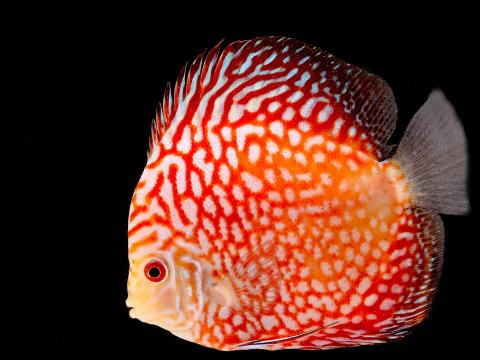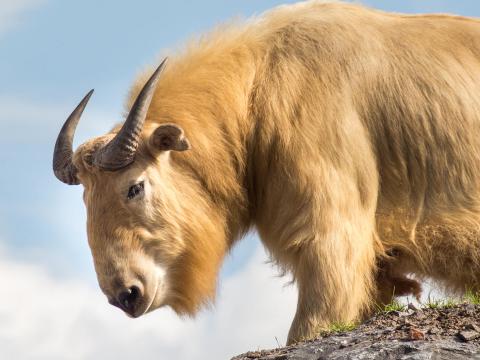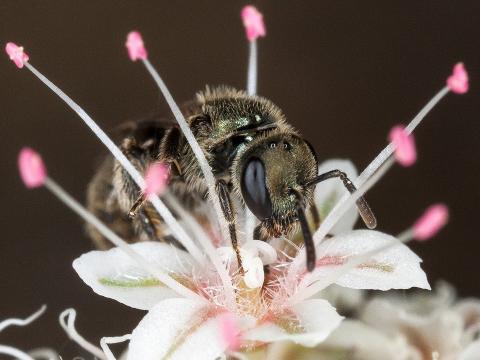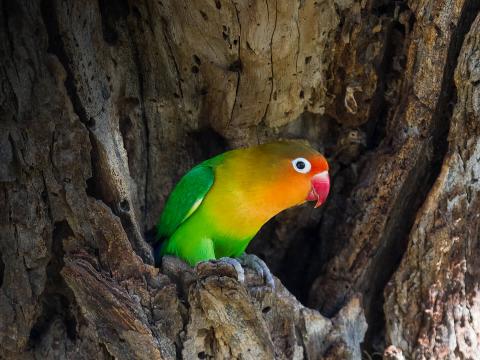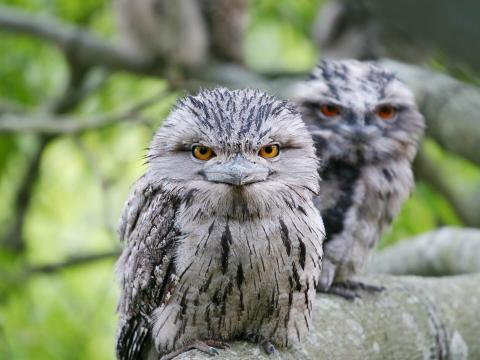Striped Hyena
- CLASS: Mammalia (Mammals)
- ORDER: Carnivora
- FAMILY: Hyaenidae
- GENUS: Hyaena
- SPECIES: hyaena
ABOUT
No dogs here! Hyenas are not members of the dog or cat families. Instead, they are so unique that they have a family all their own, Hyaenidae. There are four members of the Hyaenidae family: the striped hyena, the “giggly” spotted hyena, the brown hyena, and the aardwolf (it’s a hyena, not a wolf). They play an important role in their native habitats: cleanup crew!
Striped hyenas are a bit smaller than spotted and brown hyenas and are the least studied. They have a broad head with dark eyes, a thick muzzle, and large, pointed ears. Their muzzle, ears, and throat are entirely black, but their coat may be golden yellow, brown, or gray with black stripes on the body and legs. A mane of long hair grows along the back. The stealthy hyena camouflages well in tall, dry grass. The most striking feature on the hyena is the legs: the front legs are much longer than the hind legs. This gives hyenas their distinctive walk, making them seem like they're always limping uphill. Yet hyenas are agile and can run, trot, and walk with ease.
HABITAT AND DIET
Sub-prime real estate: Native to northern Africa, the Middle East, and India, striped hyenas eke out a life in habitat too difficult to live in for other large predators: semideserts, rocky scrublands, and savannas. They avoid true deserts and must have a water source within 6 miles (10 kilometers). Making sure privacy is respected, hyenas scent mark the edges of their territory. With sharp vision, acute hearing (really big ears!), and a keen sense of smell, hyenas patrol their territory nightly.
Hyenas have a large head and strong jaws filled with huge teeth used to crush bone. Their powerful jaws and strong teeth are a sign of their carnivorous diet. Although they are mostly scavengers, hyenas are also skilled hunters able to take down relatively large prey. Some striped hyenas even prey on sheep, goats, donkeys, and horses. When foraging, striped hyenas move in a zigzag pattern at a slow trot.
The striped hyena's diet varies by season. True to its scavenger nature, the hyena eats mammalian carrion whenever possible. Its massive jaws help the hyena crush and swallow bones, teeth, horns, and hooves—all body parts that other predators leave uneaten. The hyena's digestive system has adapted to maximize the nutritional value of what they eat; only the horns, hooves, and hair are regurgitated. But hyenas have a reputation for stealing crops like dates, melons, cucumbers, and peaches (a favorite). They also hunt small reptiles and insects, and are known to catch flying moths, grasshoppers, beetles, and termites.
Striped hyenas at the San Diego Zoo and the San Diego Zoo Safari Park are fed a fortified meat-based commercial carnivore diet, assorted fruits and vegetables, a mouse or rat, and small bones.
FAMILY LIFE
Once thought to be solitary, recent studies have shown that in some areas striped hyenas live in small groups of one female and several males. Primarily nocturnal or crepuscular, they rest out of sight during the day in a natural cave or a burrow dug into the hillside. Hyenas have even been known to take over the dens of other wildlife. None too tidy, its lair will be littered with leftover bones!
The striped hyena’s social structure may provide some advantage in protecting food sources and in defending against enemies, such as lions, tigers, leopards, and even spotted hyenas. Their greatest threat, however, comes from humans. Often, striped hyenas are hit by vehicles while eating roadkill.
Striped hyena pups certainly do not grow up in the lap of luxury. Not much is known about their secluded family life. Young are typically born at a time when food is plentiful. After a three-month gestation, mother hyena finds a cave or other sheltered place to give birth. Usually two to four fluffy babies are born with markings similar to the adults, but without the mane of hair along the back and with eyes and ears sealed. They are helpless at birth, can barely crawl, and don't open their eyes for five to nine days. They are ready to greet the world at about two weeks old. They nurse for over one year.
The young carnivores taste their first solid food at about one month old; when the mother or some of the males in her group bring food back to the den, the hungry pups bleat with anticipation. The pups chase, stalk, pounce, and ambush each other for fun and practice for future hunts. They stay with their mother for quite a while to learn proper food gathering and hunting techniques. But when the pups are two years old, she is ready for her offspring to leave, and the youngsters must find a territory all their own.
A striped hyena usually travels unnoticed, noiselessly moving through the brush. Its loudest call is a rarely heard cackling howl. The hyena makes successive rapid, brief whinnies or cackles when it is excited. Threat displays with rival hyenas begin with a growl rising to a roar, followed by a low, snapping lunge.
Unlike their noisy cousins, the spotted hyenas, striped hyenas are usually silent. Their loudest call is a rarely heard, cackling howl. But body language is a form of communication, too. In an instant, a striped hyena can nearly double in size—or at least appear much larger—by raising the hair along its back! This is not an act of aggression but the hyena’s last effort to "pretend" to be brave and, hopefully, keep what it sees as scary predators farther away. The position of the ears, tail movement, and body posture also help the hyena communicate its message to others.
Hyenas can hear sounds that human ears cannot, and they listen for sounds from other predators that may lead them to a kill that is miles away. They also have a built-in communication system: an anal scent gland to mark territory. Each hyena leaves its own unique scent.
Myths, legends, and superstitions surround hyenas. One myth claims that they eat children, yet they are also kept as loyal and trustworthy pets. Legend has it that hyenas are grave robbers, and the habit of placing tombstones on graves in the Near East began in order to prevent hyenas from digging up bodies. The people of some cultures use the dried dung of hyenas as a cosmetic face powder, and others believe that the hyena’s tongue and fat have medicinal properties. In other cultures, a striped hyena’s heart is eaten for courage, the whiskers preserved as charms.
The hyena’s reputation as a somehow distasteful, unpleasant, or even evil creature has also made its way into popular culture. The Disney animated movie The Lion King perpetuated the negative reputation of hyenas by portraying them as the “bad guys.” Yet anyone who has studied or worked with hyenas can attest to their intelligence, their cooperative social groups, and their attentive care of their young. We hope you have gained a new perception of the hyena!
CONSERVATION
The striped hyena is not considered very aggressive and usually avoids contact with other wildlife. Misunderstood and viewed as dangerous or destructive, it is poisoned, trapped, or shot for supposedly preying on livestock or raiding farms. As populations of other large carnivores decline, so does the food they leave behind that striped hyenas scavenge. Some people even mistakenly believe the hyena's body parts can be used as medicine for humans. Once numerous, the striped hyena population is dwindling and has disappeared from some areas altogether. The Barbary hyena Hyaena hyaena barbara, which lives in Algeria, Morocco, and Tunisia, is endangered.
Yet, we have much to learn from hyenas. For example, they seem to be immune to certain diseases, such as rabies and anthrax. By studying their immune system, we might find cures for humans.
By supporting San Diego Zoo Wildlife Alliance, you are our ally in saving and protecting wildlife worldwide.



